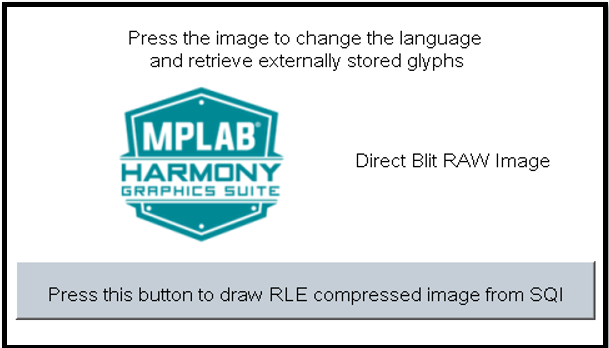
The Quickstart External Resource examples are made available in 3 methods below. Each mode demonstrates reading multiple images, multi-lingual strings and multiple font assets from both internal and external non-volatile memory (NVM).
These demonstrations are provided for application designs requiring multiple images or non-alphabet-based languages with large number of glyphs, have a very large NVM requirement for their graphics resources. In such applications, storing these graphics resources on-chip may be inefficient or impossible. The solution is to store the graphics resources to off-chip NVM, thereby preserving the on-chip NVM for program memory and allowing for more complex functional features.
Note: The application is purposely setup in single-buffer configuration to allow visual inspection of the data retrieval speed of the various images and glyphs. Observation of visual artifacts are expected.
For more information, see the following methods specified by their naming conventions.
|
Resource Mode |
Naming Convention |
|
msd_fs_sqi_flash | |
|
msd_host_sdcard_fs and msd_host_fs | |
|
x_r (external resource) |
|
Name |
Description |
|
The aria_quickstart_external_resources (MSD device reader) application demonstrates reading multiple images, multi-lingual strings and multiple font assets from both internal and external non-volatile memory (NVM). | |
|
The aria_quickstart_external_resources (MSD media storage) application demonstrates reading multiple images, multi-lingual strings and multiple font assets from both internal and external non-volatile memory (NVM). | |
|
The aria_quickstart_external_resources (external flash reader) application demonstrates reading multiple images, multi-lingual strings and multiple font assets from both internal and external non-volatile memory (NVM). | |
|
This application runs on the  SAM E70 Xplained Ultra Evaluation Kit using an SAM E70 Xplained Ultra Evaluation Kit using an  SSD1963 LCD Controller Graphics Card to drive the SSD1963 LCD Controller Graphics Card to drive the  High-Performance 4.3" WQVGA Display Module with maXTouch® Technology. High-Performance 4.3" WQVGA Display Module with maXTouch® Technology. | |
|
This application runs on the  PIC32MZ Embedded Graphics with Stacked DRAM (DA) Starter Kit attached to the PIC32MZ Embedded Graphics with Stacked DRAM (DA) Starter Kit attached to the  Multimedia Expansion Board II using GLCD peripheral display controller to drive the Multimedia Expansion Board II using GLCD peripheral display controller to drive the  High-Performance 4.3" WQVGA Display Module with maXTouch® Technology. High-Performance 4.3" WQVGA Display Module with maXTouch® Technology. | |
|
This application runs on the  Curiosity PIC32MZEF Development Board using LCC software display controller to drive the Curiosity PIC32MZEF Development Board using LCC software display controller to drive the  High-Performance 4.3" WQVGA Display Module with maXTouch® Technology. High-Performance 4.3" WQVGA Display Module with maXTouch® Technology. | |
|
This application runs on the  PIC32MZ Embedded Connectivity with FPU (EF) Starter Kit attached to the PIC32MZ Embedded Connectivity with FPU (EF) Starter Kit attached to the  Multimedia Expansion Board II using LCC software display controller to drive the Multimedia Expansion Board II using LCC software display controller to drive the  High-Performance 4.3" WQVGA Display Module with maXTouch® Technology. High-Performance 4.3" WQVGA Display Module with maXTouch® Technology. | |
|
This application runs on the  Curiosity PIC32MZEF Development Board using LCC software display controller to drive the Curiosity PIC32MZEF Development Board using LCC software display controller to drive the  High-Performance 4.3" WQVGA Display Module with maXTouch® Technology. High-Performance 4.3" WQVGA Display Module with maXTouch® Technology. | |
|
This application runs on the  SAM E70 Xplained Ultra Evaluation Kit using LCC software display controller to drive the SAM E70 Xplained Ultra Evaluation Kit using LCC software display controller to drive the  High-Performance 4.3" WQVGA Display Module with maXTouch® Technology. High-Performance 4.3" WQVGA Display Module with maXTouch® Technology. | |
|
This application runs on the  PIC32MZ Embedded Graphics with Stacked DRAM (DA) Starter Kit attached to the PIC32MZ Embedded Graphics with Stacked DRAM (DA) Starter Kit attached to the  Multimedia Expansion Board II using GLCD peripheral display controller to drive the Multimedia Expansion Board II using GLCD peripheral display controller to drive the  High-Performance 4.3" WQVGA Display Module with maXTouch® Technology. High-Performance 4.3" WQVGA Display Module with maXTouch® Technology. | |
|
This application runs on the  PIC32MZ Embedded Connectivity with FPU (EF) Starter Kit attached to the PIC32MZ Embedded Connectivity with FPU (EF) Starter Kit attached to the  Multimedia Expansion Board II using LCC software display controller to drive the Multimedia Expansion Board II using LCC software display controller to drive the  High-Performance 4.3" WQVGA Display Module with maXTouch® Technology. High-Performance 4.3" WQVGA Display Module with maXTouch® Technology. | |
|
This application runs on the  SAM E70 Xplained Ultra Evaluation Kit using LCC software display controller to drive the SAM E70 Xplained Ultra Evaluation Kit using LCC software display controller to drive the  High-Performance 4.3" WQVGA Display Module with maXTouch® Technology. High-Performance 4.3" WQVGA Display Module with maXTouch® Technology. | |
|
This application runs on the  PIC32MZ Embedded Graphics with Stacked DRAM (DA) Starter Kit attached to the PIC32MZ Embedded Graphics with Stacked DRAM (DA) Starter Kit attached to the  Multimedia Expansion Board II using GLCD peripheral controller to drive the Multimedia Expansion Board II using GLCD peripheral controller to drive the  High-Performance 4.3" WQVGA Display Module with maXTouch® Technology. High-Performance 4.3" WQVGA Display Module with maXTouch® Technology. | |
|
This application runs on the  Curiosity PIC32MZEF Development Board using LCC software display controller to drive the Curiosity PIC32MZEF Development Board using LCC software display controller to drive the  High-Performance 4.3" WQVGA Display Module with maXTouch® Technology. High-Performance 4.3" WQVGA Display Module with maXTouch® Technology. | |
|
This application runs on the  PIC32MZ Embedded Connectivity with FPU (EF) Starter Kit attached to the PIC32MZ Embedded Connectivity with FPU (EF) Starter Kit attached to the  Multimedia Expansion Board II using LCC software display controller to drive the Multimedia Expansion Board II using LCC software display controller to drive the  High-Performance 4.3" WQVGA Display Module with maXTouch® Technology. High-Performance 4.3" WQVGA Display Module with maXTouch® Technology. |
|
MPLAB® Harmony Graphics Suite
|